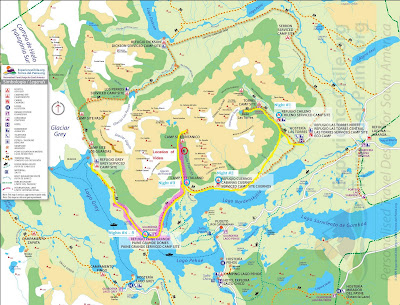We hopped on a bus on the morning of our second day in Ushuaia and took a windy 1.5 hour drive to the Estancia Harberton where our tour would begin. Along the way we stopped to check out some evidence of the harsh weather conditions that are the norm in Tierra del Fuego. The trees below are perfectly normal Southern Beech trees which had the bad fortune to be growing on the top of a ridge where they are exposed to extremely strong and consistent winds. The winds force them to grow almost parallel to the ground and for this they are called "Flag Trees" by the locals because they appear to be blowing in the wind.
The start of our tour, Estancia Harberton (Estancia roughly means ranch in English), is an interesting place for several reasons. First because it was established by one of the first missionaries (and therefore first foreign people) to settle in Tierra del Fuego and has remained in the Bridges family since 1886. The son of that original missionary, Lucas Bridges, was raised there and did a great job documenting and translating the language and history of the local Yamana people who were an extraordinary example of survival in an extreme climate with very few resources. The Estancia currently houses a small museum of local marine life and some researchers who monitor the local populations of whales, dolphins, penguins and other seagoing birds. Among the collection of things in the museum are skeletons of lots of different types of whales and penguins like the one below.
From there we took a walk across the grounds of the Estancia which contain the original buildings built by the Bridges family and hopped onto our little Zodiac to cross to the penguin island in the Beagle Channel.
There are two types of penguins on the island. The first type, of which there are only something like 24 mating pairs, is the Gentoo penguin. These penguins are the 3rd largest in the world behind the Emperor and King penguins and can grow to be up to 3 feet tall. Others of the Gentoo species do live as far south as Antarctica, however the ones we saw will probably never go their in their lifetimes.
The second type of penguin, of which there are thousands on the island, is called the Magellanic penguin. These penguins also never go to Antarctica, but rather migrate between the strait of Magellan (hence the name) and Brazil. They are rather small for penguins as they only get to the range of 2 or 2.5 feet tall.
All over the island the penguins had dug out their burrows as it was mating season. The males dig burrows and then the females choose males to mate with based on the size, location, and quality of their burrows more-so than the "beauty" or other characteristics of the males themselves. We had to walk on designated paths very slowly and carefully so we did not disturb the penguins or their nests. As you can see, they were quite used to their giant visitors and were not too scared of us.
Many of the penguins were in the process of molting during which time they must remain on the island for about 5 days without going into the water to feed while their old feathers fall off. We saw both juveniles (like the one being fed by its mother below) and adults going through the molting process.
You can tell the difference between the juveniles and adults by the coloration of their feathers.
It's hard to show with pictures just how cool this place was so I'll let the two videos below do some of the talking (along with the sound of the wind in both videos). The first video shows a good part of the area where we could walk and you can see both types of penguins with burrows in the area along with a territorial warning call to us from one of the Magellanic penguins.
The second video should give you some idea of the beauty of the Beagle Channel along with the number of penguins running all over the island.
Definitely one of the coolest experiences yet!









